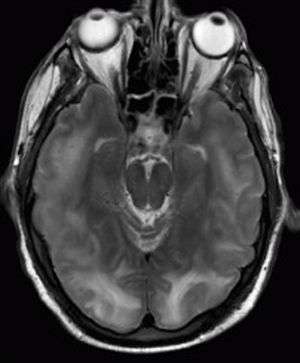Posterior reversible encephalopathy syndrome
Background
- Abbreviation: PRES
- Risk factors include: malignant hypertension, immunosuppression, eclampsia
- Poorly understood entity, but thought to be due to failure of cerebral auto-regulation in which the brain sees too high of systemic pressures leading to vasogenic edema
- Somewhat of a misnomer as changes seen on MRI are not limited to the posterior fossa and symptoms are not always reversible
- Renamed reversible posterior leukoencephalopathy syndrome (RPLS) by the American Academy of Neurology.

Magnetic resonance image showing multiple cortico-subcortical areas of hyperdense signal involving the occipital and parietal lobes bilaterally and pons in a patient with posterior reversible encephalopathy syndrome
Clinical Features[1]
Differential Diagnosis[2]
Seizure
- Epileptic seizure
- First-time seizure
- Seizure with known seizure disorder
- Status epilepticus
- Temporal lobe epilepsy
- Non-compliance with anti-epileptic medications
- Non-epileptic seizure
- Meningitis
- Encephalitis
- Brain abscess
- Intracranial hemorrhage
- Alcohol withdrawal
- Benzodiazepine withdrawal
- Barbiturate withdrawal
- Baclofen withdrawal
- Metabolic abnormalities: hyponatremia, hypernatremia, hypocalcemia, hypomagnesemia, hypoglycemia, hyperglycemia, hepatic failure, uremia
- Eclampsia
- Neurocysticercosis
- Posterior reversible encephalopathy syndrome
- Impact seizure (head trauma)
- Acute hydrocephalus
- Arteriovenous malformation
- Seizure with VP shunt
- Toxic ingestion (amphetamines, anticholinergics, cocaine, INH, organophosphates, TCA, salicylates, lithium, phenothiazines, bupropion, camphor, clozapine, cyclosporine, fluoroquinolones, imipenem, lead, lidocaine, metronidazole, synthetic cannabinoids, theophylline, Starfruit)
- Psychogenic nonepileptic seizure (pseudoseizure)
- Intracranial mass
- Syncope
- Hyperventilation syndrome
- Migraine headache
- Movement disorders
- Narcolepsy/cataplexy
- Post-hypoxic myoclonus (Status myoclonicus)
Evaluation
- Focus on altered mental status workup, with PRES as diagnosis of exclusion
- MRI shows cerebral edema, especially in posterior circulation[2]
Management
- Control Blood Pressure
- Discontinue immunosuppressants
Disposition
- Admit
See Also
References
- Staykov D. "Posterior reversible encephalopathy syndrome". PMID 21257628
- Garg RK (January 2001). "Posterior leukoencephalopathy syndrome". Postgrad Med J 77 (903): 24–8. doi:10.1136/pmj.77.903.24. PMC 1741870. PMID 11123390
This article is issued from
Wikem.
The text is licensed under Creative
Commons - Attribution - Sharealike.
Additional terms may apply for the media files.